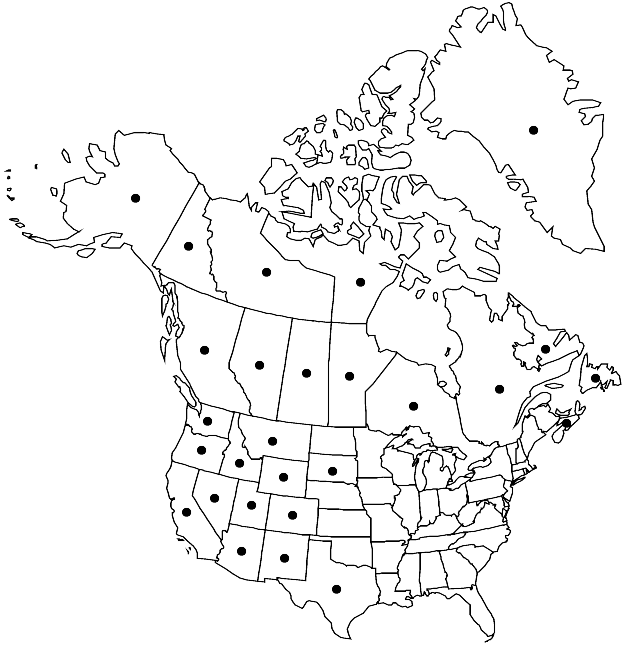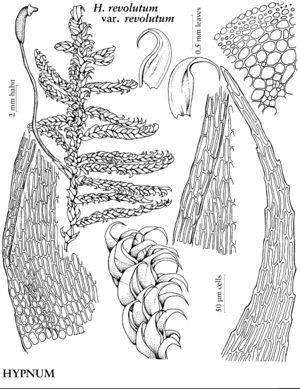Difference between revisions of "Hypnum revolutum"
Öfvers. Kongl. Vetensk.-Akad. Förh. 23: 542. 1867.
FNA>Volume Importer |
FNA>Volume Importer |
||
| Line 28: | Line 28: | ||
|distribution=North America;s South America;Europe;Asia;Antarctica. | |distribution=North America;s South America;Europe;Asia;Antarctica. | ||
|discussion=<p>Varieties 2 (2 in the flora).</p><!-- | |discussion=<p>Varieties 2 (2 in the flora).</p><!-- | ||
| − | --><p>Hypnum revolutum is circumpolar in the Northern Hemisphere but bipolar in distribution. The species occurs at sea level in the northern portion of its range but is most frequent at higher elevations. Strongly revolute leaf margins are found in the genus only in H. revolutum, and the areolation in combination with the alar cell differentiation usually make this species readily recognizable. Creeping plants tend to be pinnate, sometimes closely and regularly; suberect plants tend to be more loosely and irregularly branched. The longest branches are the ones most distant from the stem apex. Plants of H. revolutum have outer stem cell walls often thin and collapsed inward; the stem leaves are concave. The antheridial and archegonial plants are alike.</p> | + | --><p><i>Hypnum revolutum</i> is circumpolar in the Northern Hemisphere but bipolar in distribution. The species occurs at sea level in the northern portion of its range but is most frequent at higher elevations. Strongly revolute leaf margins are found in the genus only in <i>H. revolutum</i>, and the areolation in combination with the alar cell differentiation usually make this species readily recognizable. Creeping plants tend to be pinnate, sometimes closely and regularly; suberect plants tend to be more loosely and irregularly branched. The longest branches are the ones most distant from the stem apex. Plants of <i>H. revolutum</i> have outer stem cell walls often thin and collapsed inward; the stem leaves are concave. The antheridial and archegonial plants are alike.</p> |
|tables= | |tables= | ||
|references= | |references= | ||
| Line 63: | Line 63: | ||
|publication year=1867 | |publication year=1867 | ||
|special status=Selected by author to be illustrated | |special status=Selected by author to be illustrated | ||
| − | |source xml=https://jpend@bitbucket.org/aafc-mbb/fna-data-curation.git/src/ | + | |source xml=https://jpend@bitbucket.org/aafc-mbb/fna-data-curation.git/src/8f726806613d60c220dc4493de13607dd3150896/coarse_grained_fna_xml/V28/V28_850.xml |
|genus=Hypnum | |genus=Hypnum | ||
|species=Hypnum revolutum | |species=Hypnum revolutum | ||
Revision as of 17:08, 18 September 2019
Plants small to medium-sized, rusty brownish to yellowish (occasionally dark green). Stems 2–5 cm, yellow-green, erect, suberect, or creeping, regularly to irregularly pinnate, branches 0.2–0.7 cm; hyalodermis absent, central strand weakly developed; pseudoparaphyllia foliose, lanceolate to ovate. Stem leaves straight to falcate-secund, ovate or broadly ovate-oblong, gradually narrowed to apex, 0.5–1.8 × 0.4–0.6 mm; base not decurrent, not auriculate; margins revolute from base to near apex, entire at apex; apex narrowly acuminate; costa distinct to rarely ecostate; alar cells subquadrate, not pigmented, region not well defined, not excavate, 8–15 cells in marginal row, forming clearly defined angles, 2 or 3 larger, hyaline, rectangular cells in decurrent portion; basal laminal cells wider than medial cells, sometimes yellowish, walls porose, pitted; medial cells 25–40 × 4–5 µm, walls not pitted. Branch leaves similar, slightly smaller. Sexual condition dioicous; inner perichaetial leaves oblong-lanceolate, plicate, margins almost entire distally, apex short, costa indistinct. Seta yellowish to reddish when mature, 1–2 cm. Capsule inclined to horizontal, dull yellowish to brown, oblong-cylindric, 2–3 mm; annulus 2 (or 3)-seriate; operculum conic; endostome cilia 2 or 3.
Distribution

North America, s South America, Europe, Asia, Antarctica.
Discussion
Varieties 2 (2 in the flora).
Hypnum revolutum is circumpolar in the Northern Hemisphere but bipolar in distribution. The species occurs at sea level in the northern portion of its range but is most frequent at higher elevations. Strongly revolute leaf margins are found in the genus only in H. revolutum, and the areolation in combination with the alar cell differentiation usually make this species readily recognizable. Creeping plants tend to be pinnate, sometimes closely and regularly; suberect plants tend to be more loosely and irregularly branched. The longest branches are the ones most distant from the stem apex. Plants of H. revolutum have outer stem cell walls often thin and collapsed inward; the stem leaves are concave. The antheridial and archegonial plants are alike.
Selected References
None.
Key
| 1 | Plants medium-sized; leaves plicate; margins strongly revolute to near apex. | Hypnum revolutum var. revolutum |
| 1 | Plants relatively small; leaves not plicate; margins plane or sometimes revolute basally. | Hypnum revolutum var. ravaudii |
